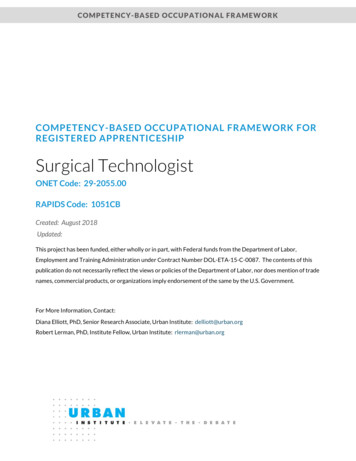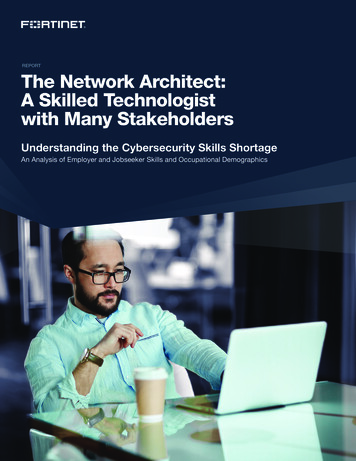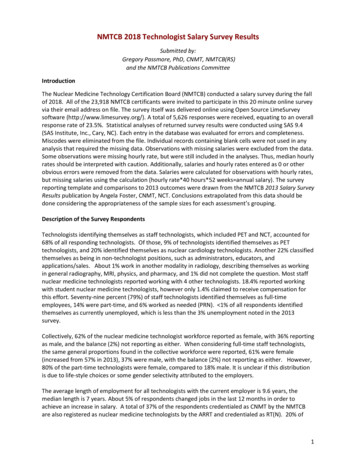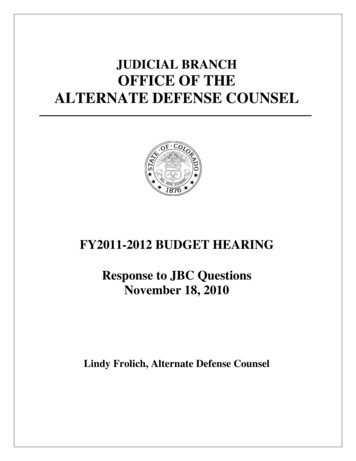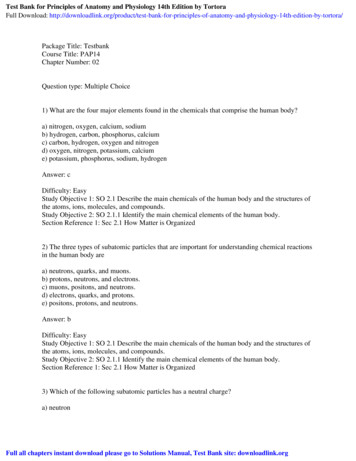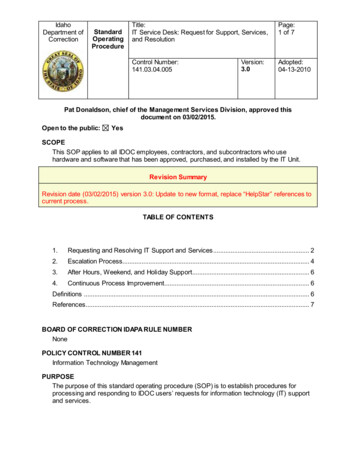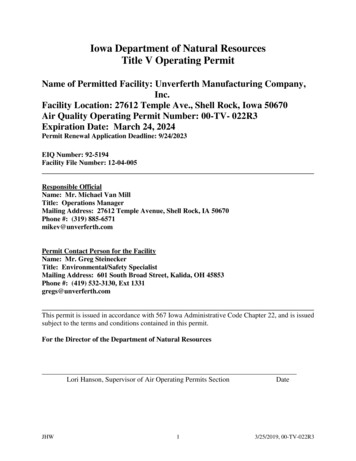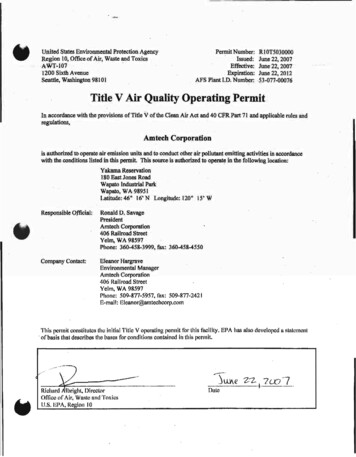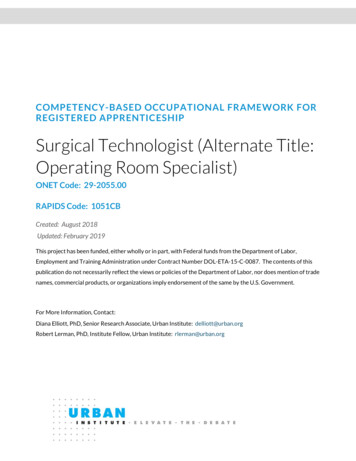
Transcription
COMPETENCY-BASED OCCUPATIONAL FRAMEWORK FORREGISTERED APPRENTICESHIPSurgical Technologist (Alternate Title:Operating Room Specialist)ONET Code: 29-2055.00RAPIDS Code: 1051CBCreated: August 2018Updated: February 2019This project has been funded, either wholly or in part, with Federal funds from the Department of Labor,Employment and Training Administration under Contract Number DOL-ETA-15-C-0087. The contents of thispublication do not necessarily reflect the views or policies of the Department of Labor, nor does mention of tradenames, commercial products, or organizations imply endorsement of the same by the U.S. Government.For More Information, Contact:Diana Elliott, PhD, Senior Research Associate, Urban Institute: delliott@urban.orgRobert Lerman, PhD, Institute Fellow, Urban Institute: rlerman@urban.org
AB O U T T HE U R BA N I NS T I T U TEThe nonprofit Urban Institute is dedicated to elevating the debate on social and economic policy. For nearly fivedecades, Urban scholars have conducted research and offered evidence-based solutions that improve lives andstrengthen communities across a rapidly urbanizing world. Their objective research helps expand opportunities forall, reduce hardship among the most vulnerable, and strengthen the effectiveness of the public sector.AcknowledgmentsWe are grateful to Rebecca Malberg von Loewenfeldt and Neelan Gupta of the Healthcare CareerAdvancement Program (“H-CAP”) for their help with this document. We also thank the manyrepresentatives of the health and medical field who contributed to this effort.Anne Wetmore, MPAWetmore & Associates,Wheaton, ILBill Gilligan, Perioperative DirectorDignity HealthSt. Mary’s, CALymus CapehartUSDOL, Alaska Apprenticeship and TrainingAlaskaSindy Rojas, Surgery Office Coordinator/Shop stewardDignity HealthSt. Mary’s, CABeth Safran-Mukai, HR OperationsEl CaminoMountain View, CATamara Stafford, Director of Talent DevelopmentEl CaminoMountain View, CABrooke Williams, Surgical TechnicianEl CaminoMountain View, CABeth Willy, Director of Clinical EducationEl CaminoMountain View, CAAndrew Colley, Operating Room ManagerKaiserSan Leandro, CAGustavo Garcia, Steward – Surg TechKaiserFremont, CASteven Gomez, Operating Room ManagerKaiserFremont, CADanielle Pollard, Workforce Planning ConsultantKaiser National Workforce Planning and DevelopmentOakland, CAMary Sandman, NCAL Talent Acquisition Leader,Allied Health – Service Line ManagerKaiser NCAL RegionOakland, CAEra Sethi, Regional Recruitment ManagerKaiser NCAL RegionSan Leandro, CARebecca Miller, Workforce DirectorSEIU UHW-WestSan Francisco, CATerrie Ridgway-Olmos, Regional Contract SpecialistSEIU UHW-WestSouth San Francisco, CA
Keni Addison, Implementation SpecialistSEIU-UHW Joint Employer Education FundSacramento, CAShani Byard, Director of Career AdvancementSEIU-UHW Joint Employer Education FundLos Angeles, CACindy Chambers, ConsultantSEIU-UHW Joint Employer Education FundScott Goodell, Program DirectorSEIU-UHW Joint Employer Education FundLos Angeles, CARebecca Hanson, Executive DirectorSEIU-UHW Joint Employer Education FundOakland, CALetitia Segura, Assistant Director, UpgradeSEIU-UHW Joint Employer Education FundLos Angeles, CA
ContentsCompetency-Based Occupational FrameworksvComponents of the Competency-Based Occupational FrameworkviUsing the Competency-Based Occupational Framework to Develop a Registered ApprenticeshipProgramviiSurgical Technologist1Occupational Overview1Occupational Purpose and Context1Potential Job Titles1Attitudes and Behaviors2Apprenticeship Prerequisites2Occupational Pathways2Certifications, Licensure and Other Credential Requirements3Job Functions3Work Process Schedule4Related Technical Instruction Plan7Cross Cutting Competencies10Detailed Job Functions12JOB FUNCTION 1: Prepare for Surgical Procedures12JOB FUNCTION 2: Perform Intraoperative Duties/Activities16JOB FUNCTION 3: Perform Postoperative Procedures and Room Turnover20JOB FUNCTION 4: Assist Circulator22JOB FUNCTION 5: Recognize and Demonstrate Knowledge of the Maintenance of SurgicalSupplies/Equipment25JOB FUNCTION 6: Provide safe environment26JOB FUNCTION 7: Perform Departmental Responsibilities29JOB FUNCTION 8: Maintain Professional Responsibility30References32Statement of Independence33IVACKNOWLEDGMENTS
Competency-Based OccupationalFrameworksThe Urban Institute, under contract by the U.S. Department of Labor, has worked with employers,subject matter experts, labor unions, trade associations, credentialing organizations and academics todevelop Competency-Based Occupational Frameworks (CBOF) for Registered Apprenticeshipprograms. These frameworks defined the purpose of an occupation, the job functions that are carriedout to fulfill that purpose, the competencies that enable the apprentice to execute those job functionswell, and the performance criteria that define the specific knowledge, skills and personal attributesassociated with high performance in the workplace. This organizational hierarchy – Job Purpose – JobFunctions – Competencies – Performance Criteria – is designed to illustrate that performing work wellrequires more than just acquiring discrete knowledge elements or developing a series of manual skills.To perform a job well, the employee must be able to assimilate knowledge and skills learned in varioussettings, recall and apply that information to the present situation, and carry out work activities usingsound professional judgment, demonstrating an appropriate attitude or disposition, and achieving alevel of speed and accuracy necessary to meet the employer’s business need.The table below compares the terminology of Functional Analysis with that of traditional OccupationalTask Analysis to illustrate the important similarities and differences. While both identify the keytechnical elements of an occupation, Functional Analysis includes the identification of behaviors,attributes and characteristics of workers necessary to meet an employer’s expectations.Framework TerminologyTraditional Task Analysis TerminologyJob Function – the work activities that arecarried out to fulfill the job purposeJob Duties – roles and responsibilities associatedwith an occupationCompetency – the actions an individual takesand the attitudes he/she displays to completethose activitiesTask – a unit of work or set of activities neededto produce some resultPerformance Criteria – the specific knowledge,skills, dispositions, attributes, speed andaccuracy associated with meeting the employer’sexpectationsSub Task – the independent actions taken toperform a unit of work or a work activityAlthough designed for use in competency-based apprenticeship, these Competency-BasedOccupational Frameworks also support time-based apprenticeship by defining more clearly andprecisely what an apprentice is expected to learn and do during the allocated time-period.COMPETENCY-BASED OCCUPATIONAL FRAMEWORKSV
CBOFs are comprehensive to encompass the full range of jobs that may be performed by individuals inthe same occupation. As employers or sponsors develop their individual apprenticeship programs, theycan extract from or add to the framework to meet their unique organizational needs.Components of the Competency-Based Occupational FrameworkOccupational Overview: This section of the framework provides a description of the occupationincluding its purpose, the setting in which the job is performed and unique features of the occupation.Work Process Schedule: This section includes the job functions and competencies that would likely beincluded in an apprenticeship sponsor’s application for registration. These frameworks provide a pointof reference that has already been vetted by industry leaders so sponsors can develop new programsknowing that they will meet or exceed the consensus expectations of peers. Sponsors maintain theability to customize their programs to meet their unique needs, but omission of a significant number ofjob functions or competencies should raise questions about whether or not the program has correctlyidentified the occupation of interest.Cross-cutting Competencies: These competencies are common among all workers, and focus on theunderlying knowledge, attitudes, personal attributes and interpersonal skills that are importantregardless of the occupation. That said, while these competencies are important to all occupations, therelative importance of some versus others may change from one occupation to the next. These relativedifferences are illustrated in this part of the CBOF and can be used to design pre-apprenticeshipprograms or design effective screening tools when recruiting apprentices to the program.Detailed Job Function Analysis: This portion of the framework includes considerable detail and isdesigned to support curriculum designers and trainers in developing and administering the program.There is considerable detail in this section, which may be confusing to those seeking a more succinct,higher-level view of the program. For this reason, we recommend that the Work Process Schedule bethe focus of program planning activities, leaving the detailed job function analysis sections toinstructional designers as they engage in their development work.a.Related Technical Instruction: Under each job function appears a list of foundationalknowledge, skills, tools and technologies that would likely be taught in the classroom toenable the apprentice’s on-the-job training safety and success.VICOMPETENCY-BASED OCCUPATIONAL FRAMEWORKS
b.Performance Criteria: Under each competency, we provide recommended performancecriteria that could be used to differentiate between minimally, moderately and highlycompetent apprentices. These performance criteria are generally skills-based rather thanknowledge-based, but may also include dispositional and behavioral competencies.Using the Competency-Based Occupational Framework to Develop a RegisteredApprenticeship ProgramWhen developing a registered apprenticeship program, the Work Process Schedule included in thisCBOF provides an overview of the job functions and competencies an expert peer group deemed to beimportant to this occupation. The Work Process Schedule in this document can be used directly, ormodified and used to describe your program content and design as part of your registration application.When designing the curriculum to support the apprenticeship program – including on the job trainingand related technical instruction – further information in Detailed Job Functions could be helpful.These more detailed job function documents include recommendations for the key knowledge and skillelements that might be included in the classroom instruction designed to support a given job function,and the performance criteria provided under each competency could be helpful to trainers and mentorsin evaluating apprentice performance and insuring inter-rater reliability when multiple mentors areinvolved.COMPETENCY-BASED OCCUPATIONAL FRAMEWORKSVII
Surgical Technologist (Alternate Title:Operating Room Specialist)Occupational OverviewOccupational Purpose and ContextSurgical technologists (also referred to as “Operating Room Specialists”, but will be referenced asSurgical Technologist in this document and aligning materials) work as members of a healthcare teamalongside physicians and surgeons, registered nurses, and other healthcare workers.Before an operation, surgical technologists prepare the operating room by setting up surgicalinstruments and equipment. They also prepare patients for surgery by washing and disinfecting incisionsites, positioning the patients on the operating table, covering them with sterile drapes, and taking themto and from the operating room. Surgical technologists prepare sterile solutions and medications usedin surgery and check that all surgical equipment is working properly. They help the surgical team put onsterile gowns and gloves.During an operation, surgical technologists pass instruments and supplies to surgeons and firstassistants. They also hold retractors, hold internal organs in place during the procedure, or set uprobotic surgical equipment. Technologists also may handle specimens taken for laboratory analysis.Once the operation is complete, surgical technologists may apply bandages and other dressings to theincision site. They may also help transfer patients to recovery rooms and restock operating rooms aftera procedure.Potential Job TitlesSurgical Technologist; Tech in Surgery – Certified; Certified Surgical Technologist; Operating RoomTechnicianWORK PROCESS SCHEDULE1
Attitudes and BehaviorsPersons who are successful in becoming surgical technologists possess a strong sense of responsibility,are able to anticipate and respond appropriately to perceived needs without being asked, and haveconsiderable patience and concern for others. Such persons function well in a team, perform accuratelyand efficiently under pressure, and possess manual dexterity and fine motor coordination.Other terms to describe attitudes and behaviors of surgical technologists include: Efficient, emotionallystable, ethical, flexible, able to follow directions, honest, intuitive, organized, hygienic, physically fit, punctual,receptive, reliable, respecting of patient privacy, responsible, possessing a sense of humor.Apprenticeship PrerequisitesSurgical Technologists must complete post-secondary training (from a one year program to anAssociate’s Degree program) and/or have experience as a surgical assistant in a medical or militarysetting. Surgical technology education programs include courses in anatomy, physiology, biology,medical terminology, pharmacology and anesthesia, microbiology, pathophysiology, and often sometechnological and other instruction. Previous certification as a surgical technologist, a set number ofyears of experience as a surgical technologist, and/or military training and experience as a militarysurgical technologist can qualify a person to take the certification exam for certification renewal,depending on the type of certification. Participation in a training program requires a completebackground check, documentation of current required-immunizations and current Healthcare ProviderCardiopulmonary Resuscitation (CPR) certification.Occupational PathwaysIn addition to persons in other health care positions, some people move into surgical technology bygetting credentialing following a BS in Biology or health-related field.Some surgical technologists become specialized surgical technicians, with expertise in woundpreparation, plastic surgery, neurosurgery, organ transplantation, sterilization, pharmacology,anesthesia, or heart surgery.2WORK PROCESS SCHEDULE
Some surgical technologists advance to become Surgical First Assistants. Surgical first assistants oftenwork as surgical technologists and receive additional on-the-job training before becoming firstassistants. Others may complete a formal education program in surgical assisting. Surgical firstassistants have a hands-on role, directly assisting surgeons during a procedure. For instance, they mayhelp to suction the incision site or suture a wound.Other career pathways for surgical technologists include moving into nursing or hospital managementpositions.Certifications, Licensure and Other CredentialRequirementsCREDENTIALOffered ByBefore, During orAfter ApprenticeshipCertified SurgicalTechnologist (CST)Tech in SurgeryCerified:TS-C(NCCT)National Board of Surgical Technology andSurgical AssistingNational Center For Competency TestingBeforeBefore or duringJob FunctionsJOB FUNCTIONSCore orOptional1.Prepare for Surgical ProceduresCore2.Perform Intraoperative Duties/ActivitiesCore3.Perform Postoperative Procedures and Room TurnoverCore4.Assist CirculatorCore5.Core6.Recognize and Demonstrate Knowledge of the Maintenance of SurgicalSupplies/EquipmentProvide Safe Environment7.Perform Departmental ResponsibilitiesCore8.Maintain Professional ResponsibilityCoreWORK PROCESS SCHEDULELevelCore3
Work Process ScheduleWORK PROCESS SCHEDULE 1O*NET-SOC Code: 292055.00Surgical Technologist (Alternate Title:Operating Room Specialist)RAPIDS Code: 1051CBJob Title:Level:Specialization:Stackable Program yes noBase Occupation Name:Company Contact:Address:Phone:Apprenticeship Type:Prerequisites:Competency-BasedOne-year accreditation program or associate’sdegreeTime-Based HybridEmail:Background checkDocumentation of immunizationsCurrent health care provider CPR certificationJOB FUNCTION 1: Prepare for Surgical ProceduresCompetenciesCore orOptionalA. Prepare the operating room environment according to thesurgical procedureCoreB. Prepare for the specific procedureCoreC. Establish sterile fieldCoreRTIOJT1 See full framework for certifications and occupational pathways, cross-cutting competencies, and detailed jobfunctions at https://www.dol.gov/cgi-bin/leave-dol.asp?exiturl hips&exitTitle www.urban.org.4WORK PROCESS SCHEDULE
D. Take preoperative precautionsCoreE.Prepare the patient and surgical teamCoreF.Participate in surgical time outCoreJOB FUNCTION 2: Perform Intraoperative Duties/ActivitiesCompetenciesCore orOptionalA. Maintain the operating room environment according tosurgical procedureCoreB. Provide the surgical team members with supplies requiredfor the procedureCoreC. Assemble and test materials and specialty equipment duringsurgeryCoreD. Anticipate needs during surgeryCoreE.Provide intraoperative assistance when delegated by asurgeonCoreF.Handle medications, solutions, and specimens appropriatelyCoreG. Perform closing sponge, needle, and instrument countsRTIOJTRTIOJTRTIOJTCoreJOB FUNCTION 3: Perform Postoperative Procedures and Room TurnoverCompetenciesCore orOptionalA. Conduct postoperative patient careCoreB. Dispose of wasteCoreC. Conduct room turnover after surgeryCoreJOB FUNCTION 4: Assist CirculatorCompetenciesCore orOptionalA. Assist with/provide patient careCoreB. Assist with supplies and equipmentCoreJOB FUNCTION 5: Recognize and Demonstrate Knowledge of the Maintenance of SurgicalSupplies/EquipmentCompetenciesCore orOptionalA. Wash and decontaminate instrumentsCoreWORK PROCESS SCHEDULERTIOJT5
B. Ultrasound, milk, rinse and dry instrumentsCoreC. Assemble instrument traysCoreD. Prepare for and operate sterilizersCoreJOB FUNCTION 6: Provide Safe EnvironmentCompetenciesCore orOptionalA. Maintain a safe preoperative environmentCoreB. Maintain a safe intraoperative environmentCoreC. Maintain a safe postoperative environmentCoreD. Practice precautions with critical equipmentCoreE.CorePractice general safety precautionsRTIOJTRTIOJTRTIOJTJOB FUNCTION 7: Perform Departmental ResponsibilitiesCompetenciesCore orOptionalA. Receive/participate in dept. communicationsCoreB. Inventory suppliesCoreC. Rotate suppliesCoreD. Order suppliesCoreE.Create/update surgeon preference cardsCoreF.Attend inter/intra departmental committeesCoreG. Maintain cleanliness of departmentCoreJOB FUNCTION 8: Maintain Professional ResponsibilityCompetenciesCore orOptionalA. Maintain institutional competenciesCoreB. Practice cost containmentOptionalC. Attend/contribute to in-service classesCoreD. Evaluate new equipmentOptionalE.Precept new employees/studentsCoreF.Participate in performance improvement activitiesCore6WORK PROCESS SCHEDULE
Sample Related Instruction OutlineNote: Accredited instruction plans for surgical technologists vary across training institutions. The plandescribed below is an example of coursework required for a basic degree in Surgical Technology. Otherplans, especially those for an Associate Degree in Surgical Technology, can include additional corecurricula.COURSE NAME: General Anatomy and PhysiologyCourse NumberHours: 60 totalLEARNING OBJECTIVESGeneral Anatomy and Physiology examines basic concepts of human anatomy and physiology asthey relate to hea
Apr 05, 2019 · setting. Surgical technology education programs include courses in anatomy, physiology, biology, medical terminology, pharmacology and anesthesia, microbiology, pathophysiology, and often some technological and other instruction. Previous certification as a surgical technologist, a
